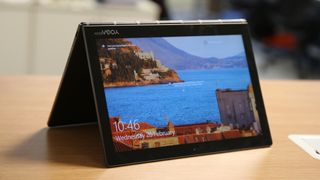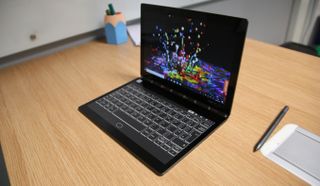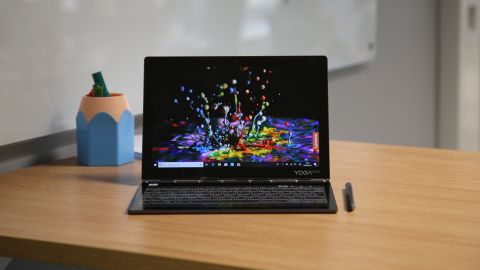Why you can trust TechRadar
Here’s how the Lenovo Yoga Book C930 performed in our suite of benchmark tests:
Cinebench CPU: 230 points; Graphics: 34 fps
Geekbench 4 Single-Core: 3,648; Multi-Core: 6,809
PCMark 8 (Home Test): 2,360
PCMark 8 Battery Life: 4 hours and 5 minutes
Battery Life (TechRadar movie test): 7 hours and 58 minutes
With a seventh generation Intel Core i5-7Y54 CPU, which is a dual-core mobile Kaby Lake processor that was released back in 2016, and just 4GB of RAM, anyone expecting the Lenovo Yoga Book C930 to feature cutting edge (and powerful) components will be disappointed.
As far as laptops go, 4GB of RAM doesn’t really cut it anymore, and we like to see 8GB at least in a laptop at this price range. The low specs are necessary to keep the machine so thin and light, but it does mean that if you want a laptop with enough power to handle tasks like photo and video editing, then this is not the laptop for you.
So, once again we’re left with a laptop where we have to caution potential buyers into lowering their expectations. If you want a laptop/tablet hybrid uniquely capable of writing documents, browsing the internet and reading ebooks, then arguably there’s no better laptop on the market.

However, if you’re after a more future-proof laptop that can handle intensive tasks, then you’re going to be disappointed by the performance of the Lenovo Yoga Book C930. The problem is that, at this price point, you shouldn’t feel like you’re making compromises or having to lower your expectations.
There’s a lot of powerful, capable laptops out there at this price range, such as the Dell XPS 13 and the even cheaper Huawei MateBook 13, which both sit at the top of our best laptops guide. They offer much more up-to-date components and better performance, while in the XPS 13’s case offering a thin and light laptop that’s comparable to the Yoga Book C930’s svelte design.
What those devices don’t offer is LTE mobile data or the dual screen design of the Yoga Book C930. So, when considering Lenovo’s latest offering, you’re faced with a stark decision: is the E Ink second display worth the expense? If you can live without it, then your money is better off spent on a more capable laptop.
However, despite its low specs, the Yoga Book C930 performs well for day-to-day tasks, and Windows 10 works well on it on the whole. We've witnessed a few times when things slow to a crawl as it loads up apps, or tries to juggle a number of tasks at once.
Again, the secondary screen works very well as a keyboard and touchpad – even supporting multi-touch gestures. However, if you’re going to be typing on this device for long periods of time, then you’ll probably want to plug in an external keyboard, but for firing off quick emails and taking notes, it does the job well.
The phrase ‘does the job well’ can be applied to the overall performance of the Lenovo Yoga Book C930 – as you can see from our benchmark results – which sadly is damning with faint praise considering the price of the laptop.

Battery life
The only area that the Yoga Book C930 comes close to impressing when it comes to performance is in battery life, with the laptop racking up a decent 7 hours and 58 minutes in our battery test, where we run a looped 1080p video with the screen at 50% brightness.
This will see you through long flights or journeys while watching a movie, and with the fantastic screen quality of the Yoga Book C930, that’s something you’ll likely want to use this device for.
E Ink displays are also famous for not being too battery-hungry, so the addition of a second screen doesn’t appear to impact the Yoga Book C930’s battery life in any major way.
In the more intensive PCMark 8 Home battery life test, which emulates tasks such as word processing, web browsing and video calling, the battery lasted a less impressive 4 hours and 5 minutes. In our day-to-day use, we found the Yoga Book C930 will last a full work day – as long as you're careful – but not much longer.

Final verdict
The Yoga Book C930 comes tantalizingly close to being a great laptop, but sadly it falls short. There’s a whole lot to love about the device, from its thin and light design, gorgeous main screen and innovative E Ink secondary screen.
That second screen in particular is impressive, and does an impressive job at acting like a standard keyboard, while also allowing you to jot down notes and read ebooks. The E Ink display offers features and a level of versatility that the Yoga Book C930’s competitors simply don’t have.
However, its not a perfect device, and some of its shortcomings lead to genuine frustration. We’d have loved for Lenovo to pack more powerful components into the Yoga Book C930. For the price Lenovo is asking for the Yoga Book C930 in 2019, an almost 3-year-old, dual-core CPU and 4GB of RAM just isn’t going to cut it.
With those specs, you may find your expensive new Yoga Book C930 could start to feel pretty old in only a few years. When you’re spending this kind of money, you want to know your laptop will last you for a long while.
Meanwhile, fans of the original Yoga Book will probably like the sound of the upgrades – but be totally put off by the massive leap in price.
So, where does that leave the Yoga Book C930? Lenovo does so many things right here, but its underpowered components and high price mean we can’t heartily recommend it. It does at least give us hope for the next generation of Yoga Book – for Lenovo is so very close to acing this.
Image Credits: TechRadar

Matt is TechRadar's Managing Editor for Core Tech, looking after computing and mobile technology. Having written for a number of publications such as PC Plus, PC Format, T3 and Linux Format, there's no aspect of technology that Matt isn't passionate about, especially computing and PC gaming. Ever since he got an Amiga A500+ for Christmas in 1991, he's loved using (and playing on) computers, and will talk endlessly about how The Secret of Monkey Island is the best game ever made.

